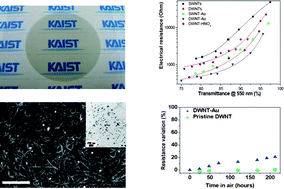Recent advances in hybrids of carbon nanotube network films and nanomaterials for their potential applications as transparent conducting films
Abstract
The use of

* Corresponding authors
a
Department of Chemical and Biomolecular Engineering, Korea Advanced Institute of Science and Technology, Daejeon, Korea
E-mail:
heetae@kaist.ac.kr
Fax: +82-42-350-3910
Tel: +82-42-350-3931
b KCC Central Research Institute, 83 Mabook-dong, Giheung-gu, Yongin-si, Gyunggi-do, Korea
c Ministry of Knowledge Economy, Bio & Nano Tech Industries Division, Office of Industries, 88 Gwanmoonro, Gwacheon-si, Gyunggi-do, Korea
d Nanomechanical Systems Research Division, Korea Institute of Machinery and Materials (KIMM), Daejeon, Korea
e Top Nanosys Incorporated, Suwon, Korea
The use of

 Please wait while we load your content...
Something went wrong. Try again?
Please wait while we load your content...
Something went wrong. Try again?
S. B. Yang, B. Kong, D. Jung, Y. Baek, C. Han, S. Oh and H. Jung, Nanoscale, 2011, 3, 1361 DOI: 10.1039/C0NR00855A
To request permission to reproduce material from this article, please go to the Copyright Clearance Center request page.
If you are an author contributing to an RSC publication, you do not need to request permission provided correct acknowledgement is given.
If you are the author of this article, you do not need to request permission to reproduce figures and diagrams provided correct acknowledgement is given. If you want to reproduce the whole article in a third-party publication (excluding your thesis/dissertation for which permission is not required) please go to the Copyright Clearance Center request page.
Read more about how to correctly acknowledge RSC content.
 Fetching data from CrossRef.
Fetching data from CrossRef.
This may take some time to load.
Loading related content
